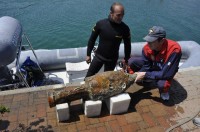 A Roman merchant vessel that sank between the 1st century B.C. and the 1st century A.D. has been found buried in the mud of the seafloor off the coast of Varazze, a town 18 miles from Genova in the northeastern Italian region of Liguria. The ship was full of cargo when it sank, and since it has been protected by layers of mud, archaeologists think it is virtually intact. An estimated 200 amphorae remain unbroken in the cargo hold, their pine caps sealed with pitch still in place.
A Roman merchant vessel that sank between the 1st century B.C. and the 1st century A.D. has been found buried in the mud of the seafloor off the coast of Varazze, a town 18 miles from Genova in the northeastern Italian region of Liguria. The ship was full of cargo when it sank, and since it has been protected by layers of mud, archaeologists think it is virtually intact. An estimated 200 amphorae remain unbroken in the cargo hold, their pine caps sealed with pitch still in place.
Fishermen have been recovering broken pieces of amphora in the area since the 1930s, but the precise location of the wreck was unknown. In March of this year, Varazze fisherman Francesco Torrente caught a long-necked amphora in his net. He reported his discovery to the police who explored the area with sonar for the next five months, narrowing down the probable wreck site. Police divers and their cable-guided submersible vehicle Pluto explored the smaller area in careful detail and found the wreck itself.
The top deck is littered with the broken remains of clay vessels damaged by millennia of fishing nets dragging through them, but the sonar data indicates the hold is full of intact amphorae. Lt. Col. Francesco Schilardi, leader of the police divers, thinks foodstuffs like wine, olive oil, grains and garum, the ubiquitous Roman condiment made from bacteria-fermented fish intestines, might be recoverable from the sealed containers. It could prove to be a treasure trove of information about Roman food, commercial shipping and trade. The Ligurian coast was a stop on the busy trade route between Spain and central Italy.
Angelo Delfino, the mayor of Varazze, has sealed off the wreck site to prevent would-be looters from making off with souvenirs. No fishing or other water traffic is allowed. Should somebody be able to scrape together a dime or two, it is theoretically possible that the wreck could be excavated thoroughly and even raised. Given the general brokeness of the government, this is not likely to happen anytime soon.
Meanwhile, Pluto and the divers have recovered an excellent, almost complete example of an early amphora from the shipwreck. The vessel will be desalinized and conserved. Archaeologists hope they’ll be able to find the amphora’s maker’s mark once they’ve removed the barnacles and concretions. Knowing who made the vessel and where will help pin down the ship’s dates and hopefully its movements.
Here’s Pluto on the wreck site grabbing amphorae with his pincer hand:
[youtube=http://www.youtube.com/watch?v=5W053M1x_A0&w=430]
It may just be me but… garum does not sound very appetizing.
Oh it’s definitely not just you. The Romans put that stuff on everything, though. Even dessert. :no: